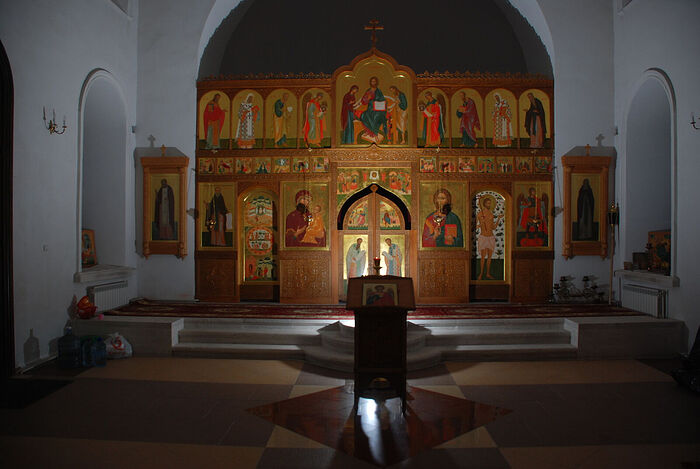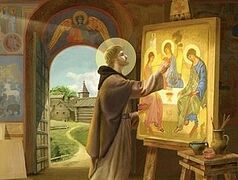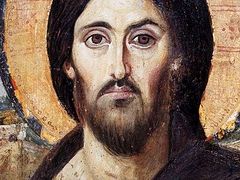Part 1: “When Designing the icon of a New Martyr, I ask the advice of his children and parishioners”
The science of color in an icon
 St. John of Shanghai —You have taught since 1995. What is the job of teaching for you?
St. John of Shanghai —You have taught since 1995. What is the job of teaching for you?
—It literally takes three-fourths of my life. In addition to St. Tikhon’s University, I teach at the Moscow State V.N. Surikov Academic Art Institute. At the Department of Painting I teach the subject “Copying Tempera Painting” in the restoration studio under the guidance of A.A. Kozmin. I also taught students from the monumental studio for a long time. Training is built there on studying and copying icons in the halls of the Tretyakov Gallery and in the exposition of the Andrey Rublev Museum. For future restorers and monument specialists this is a very important experience that will be useful in their profession.
My senior colleagues, artists Eugene Nikolaevich Maksimov and Professor Sergei Alexandrovich Gavrilyachenko are devoted to teaching, giving all their energies to training the younger generation of artists, and for me their teaching and experience is a valuable example. A teacher lives through every work of his student. I can say the same about my teachers at the school of iconography (now it is the Iconography Department). I try to work in the same way, because teaching is a special activity: you help a person understand what the icon is, how to find himself in iconography, and fulfil his aspirations competently. Sergei Alexandrovich has been the head of our state examinations commission for over twenty years, and the presentation of theses is very informative and interesting. His remarks and advice are highly professional—they create a special creative atmosphere of discussion and pose problems and tasks for young church artists. Eugene Nikolaevich Maksimov heads the arts councils at our university.
 —Are modern students different from those who came in the 1990s?
—Are modern students different from those who came in the 1990s?
—Most students who decide to devote themselves to Church art, both then and now, are very good and diligent. Many of them come from church families, and it is very pleasant for us teachers to work with them. Some decide to study on their relatives’ advice and do not fully understand the chosen specialty, and understanding and zeal for classes come later. Earlier this was not the case.
My first students often came with an academic art education behind them, the experience of faith acquired through suffering, and a conscious and thought-out choice of the path of iconography. They studied, putting their whole hearts into the work. Many now run their own schools of iconography. Others have become priests, while others have been able to build a chapel according to their architectural drawings, or compose a service to a saint, or elaborate an icon with scenes around the sides.
I also notice (and not only me) that living in a space saturated with information, with rapidly changing pictures on gadgets, modern students find it very hard to concentrate and immerse themselves in iconography, which requires deep concentration.
 Vladimir Icon of the Mother of God —When do you let your students try their hand at creating new iconography?
Vladimir Icon of the Mother of God —When do you let your students try their hand at creating new iconography?
—At our university, the Sub-department of Iconography of the Department of Church Art is very large—there are eight training studios. It is headed by the iconographer Ekaterina Dmitrievna Sheko. Training takes place according to a generally approved curriculum, in which all tasks are distributed by year of study—from simple tasks to more complex ones. In addition, each studio has its own leader, an iconographer and teacher, its own creative field and its own particulars in teaching iconography where students get a special, interesting experience. This variety of trends and educational methods in each studio is carefully maintained by the head of the department and is one of the merits of our university.
By the fifth year, when students have learned the basics of drawing, painting, composition and the language of the icon by copying ancient examples, we begin to create a new icon. It is done throughout an academic year and requires hard work from both students and their teachers. As a result of joint efforts, a new icon of a saint is born.
Over many years of work, I have prepared a whole curriculum on the methods of teaching the design of a new icon. I hope that I will be able to publish it as a textbook for teaching future iconographers.
When studying at our studio, special attention is given to the science of color. For a deeper study of the color composition of the icon, the consultations with the Honored Artist of the Russian Federation Milya Ravilievna Gataullina, who speaks about color composition and the figurative meaning of color in Church art, have become indispensable for us.
I have been teaching for over twenty-eight years, and Fr. Vladimir Vorobiev is a model of selfless service for me: before our eyes the university is growing and growing. But along with the growth, new challenges arise that Fr. Vladimir has to address all the time.
—What in contemporary Church art makes you sad?
—It is sad that many people without an education or who are undereducated have come to Church art. Moreover, they begin to have their own voice, creating pseudo-icons. As a result, we have a lot of poorly painted churches and iconostases, in front of which it is hard to pray. Unfortunately, these poorly educated people actively advertise themselves: They paint tasteless, amateur icons and have no desire to study something seriously and thoroughly. But they want to acquire a quick effect and fame by any means...
Genuine art requires a deep and thoughtful attitude, study and research. It takes a lot of work, time and effort to create a quality product.
At the very beginning, when I was just starting to teach, we all believed that the revival of Church art had begun, that soon we or our students would produce another Andrey Rublev, and all churches would be painted as they had been in a bygone age. But this did not happen. True, all of our alumni are wonderful and work hard, many of them are already well-known iconographers who do good work; but no new Andrey Rublev has appeared in contemporary Church art. Over the years of teaching, I realized that the revival of Church art in the way we imagined it is impossible. Because all of us, modern people, live in an absolutely different spiritual reality. The ancient great iconographers were, first of all, the bearers of a high spiritual culture, and therefore their icons and paintings are unsurpassed masterpieces.
What should we, modern iconographers, do? Use all our skills and experience to the best of our ability for the good of the Church, work conscientiously and professionally, carefully preserving the legacy of our great predecessors.





